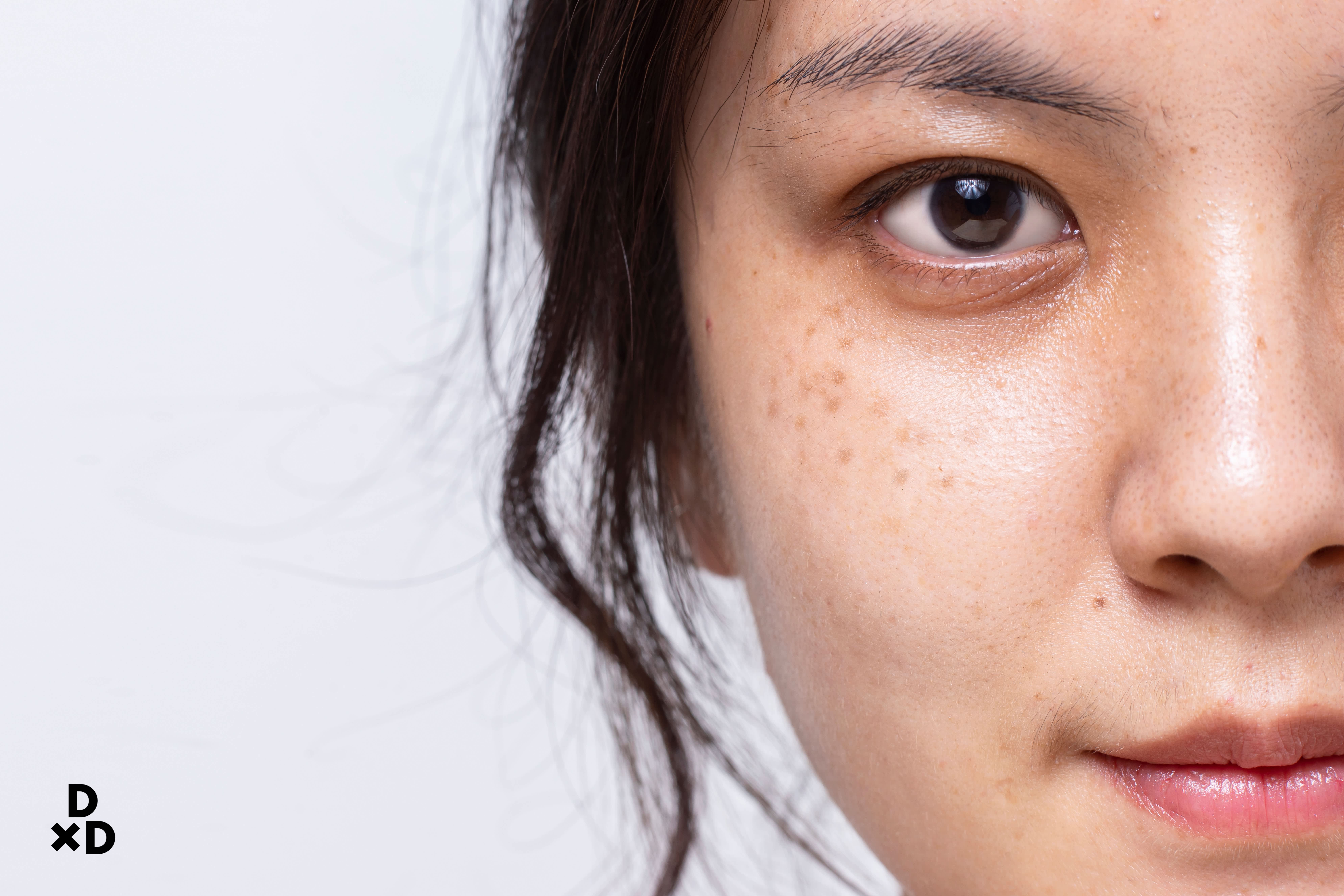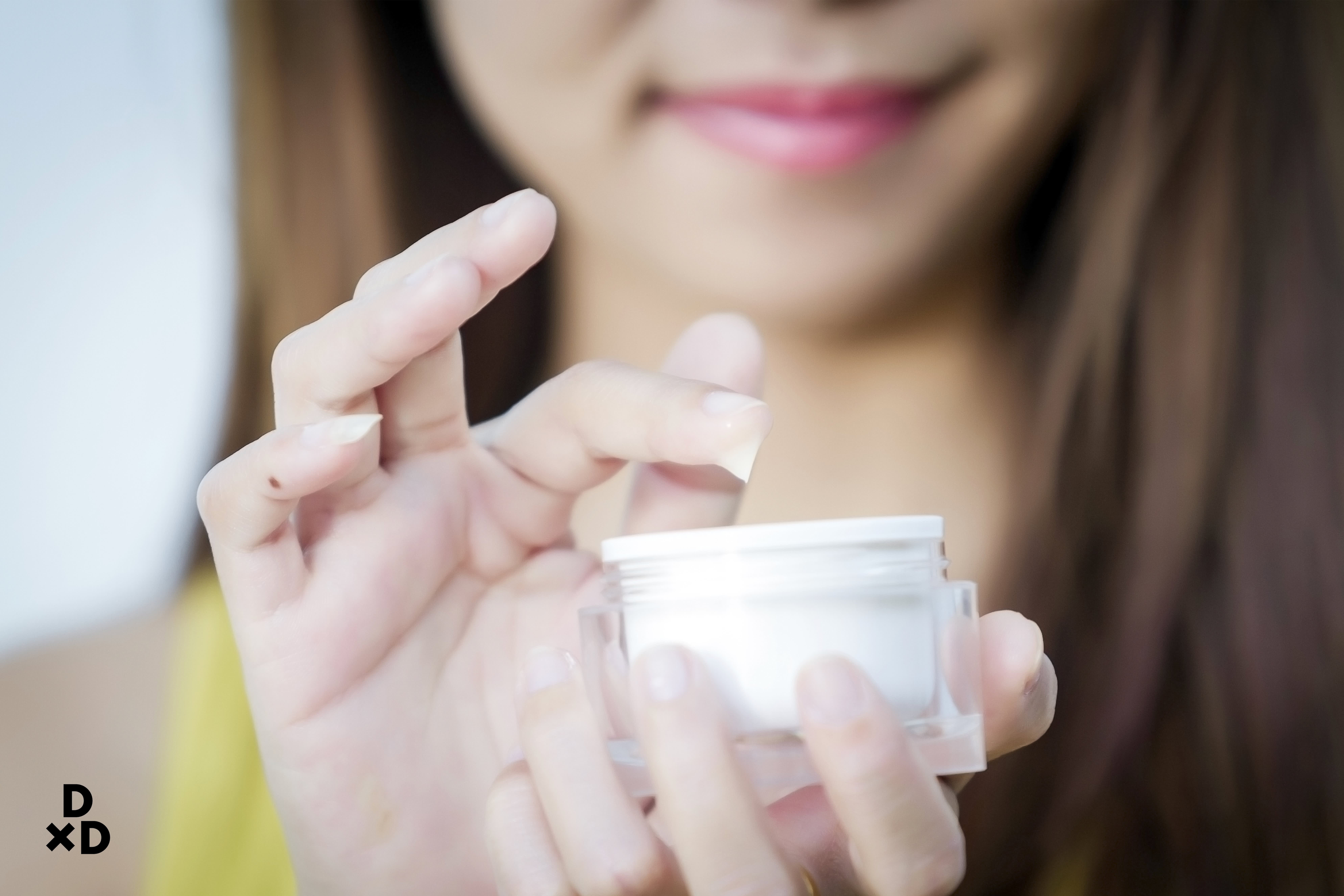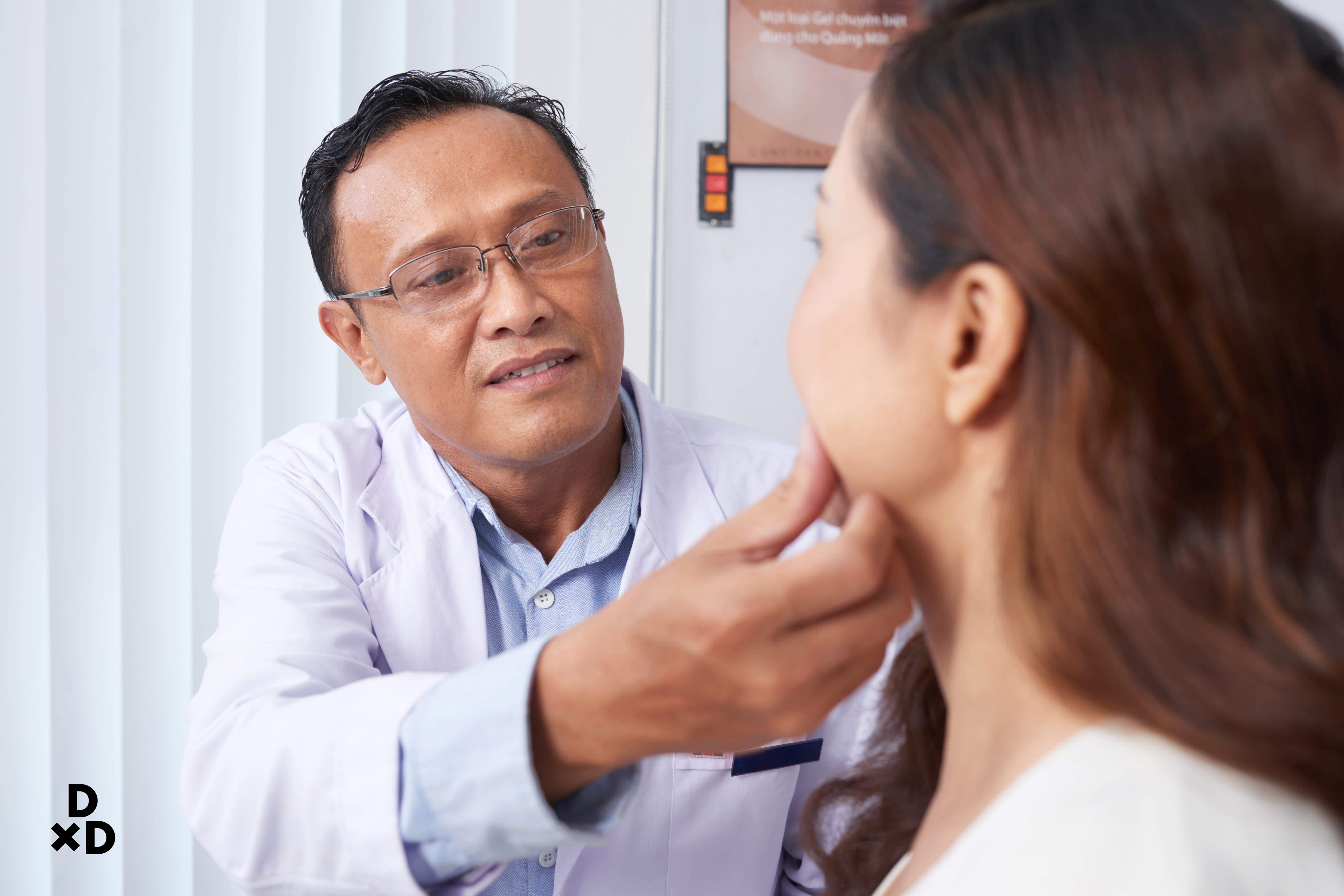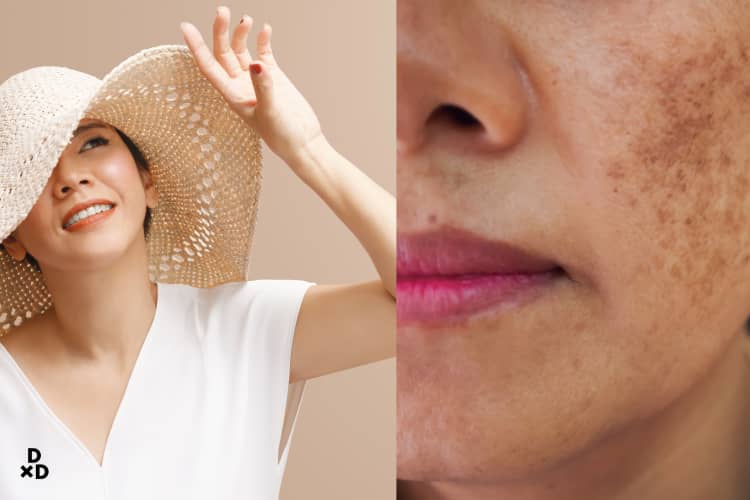Skin pigmentation or dark spots can happen over time or by genetic disposition. The colour of our skin is determined by the amount of melanin we have, and our skin lightens or darkens based on our body’s production of melanin.
Some people have grown to appreciate certain pigmentation on their skin, like freckles, while other forms of pigmentation may affect our quality of life, or it could even be telling of underlying skin diseases. Let Dr K K Chew walk you through all you need to know about skin pigmentation, when it’s a cause for concern and the possible treatments you could undergo.
What is skin pigmentation?
Skin pigmentation or hyperpigmentation is a condition where excess melanin, a brown pigment found naturally in humans, is produced and deposited, resulting in dark coloured patches on the skin. [1]
Melanin gives the skin its colour and hence, overproduction of melanin can be a result of a variety of factors such as sun exposure, genetic factors, age, hormones or skin injuries and inflammation.
What are the types of pigmentation disorders?
Types of pigmentation disorders can be classified into 2 categories based on where the melanin is concentrated: epidermal and dermal.
Epidermal

- Freckles
These are small pigmented macules (areas of skin discolouration) that are less than 0.5 cm wide. They tend to appear early in childhood or when exposed to sunlight due to stimulation by ultraviolet (UV) light. [1]
Freckles are known to be genetic and can be divided into ephelides and solar lentigines. Both are flat macules but differ when it comes to development and morphology.
- Ephelides
Ephelides are small spots of pigments found on the face, arms, neck and chest. They are observed in young fair-skinned or red-haired people, normally Caucasians. They increase in adolescents and can partially fade with age. [2]
- Lentigines
These are larger pigmentation spots than ephelides and are found mostly on the face and arms. This more commonly occurs in the elderly over the age of 50 and can accumulate due to chronic exposure to the sun. [2]
- Melasma or Chloasma
This occurs as blotches over the face, commonly in areas such as the cheeks, upper lip, chin, and forehead. [3] Note that Melasma is usually epidermal, although it can occur in dermal forms as well. Dermal melasma can cause blue or black pigmentation.
Also known as the “mask of pregnancy”, melasma occurs more frequently in pregnant women due to hormonal changes in the body. The production of melanocyte-stimulating hormones increases along with estrogen and progesterone, all of which contribute to melanosis. [4]
Read also: 5 Safer Ways to Treat Melasma for Darker Complexions Effectively
- Post-inflammatory hyperpigmentation
This occurs during the healing process of a skin injury or trauma that leaves a flat area of discolouration on the skin. Those with acne problems often experience this, although it can be caused by cosmetic procedures such as dermabrasion, laser treatment or chemical peels too. [5]
Read also: What is the best treatment for post-inflammatory hyperpigmentation in Singapore?
Dermal
- Acquired, Bilateral Naevus of Ota-like Macules (ABNOM) or Hori’s Naevus
The naevus occurs as bluish-grey, bilateral and symmetric hyperpigmented macules or patches, and affects mainly on the forehead or the cheeks in the middle and upper dermis. [6]
The macules do not occur on the ocular (eye) or mucosal membranes. Young and middle-aged Asian women are more likely to have ABNOM, and some reports show a link towards family history.
The lesions may “merge” and become more greyish over time. They can get darker from chronic exposure to the sun or during pregnancy. Meanwhile, the colour of the naevus tends to vary with menstruation.
The causes of ABNOM can be the following:
- Inflammation
- Atrophy or degeneration of the epidermis and dermis from ageing
- Hormones
- Trauma
- UV damage from sun exposure
Read also: How can I ensure I get the most protection from UV damage and repair any damage already incurred?
What causes pigmentation of the skin?
The sun is normally the triggering factor for pigmentation of the skin, although some chemicals may cause skin pigmentation as well. These can trigger the melanocytes to produce melanin, the pigment responsible for the dark coloured spots on your skin.
The production of melanin in response to the exposure to UV rays from the sun is actually a protective mechanism against skin cancer. This is also the reason why people with dark skin are less likely to get skin cancer — they’re naturally protected!
Can skin pigmentation be removed permanently?

If you’re asking whether skin pigmentation can be removed completely, the answer is yes. It can be removed but it may come back depending on your lifestyle and predisposition.
You may be able to get rid of those dark spots permanently, but if you frequently suntan or spend hours under the sun, then it is possible that the dark spots may return. Freckles have a better chance of permanent removal. Only about 10% of the freckles remain after treatment of certain cases of skin pigmentation.
Are there any complications if I leave my skin pigmentation untreated?
Fortunately, the commonly seen skin pigmentation conditions are mostly only cosmetic defects which are not linked to other conditions.
For those that are caused by underlying medical conditions, we advise that you seek treatment for the specific condition rather than just the dark spots.
What can I expect from my first consultation?
In the first consultation, we will establish a diagnosis for the skin pigmentation and determine its root cause.
The diagnosis will be a clinical one, done by visually examining the skin pigmentation. We might use a dermascope, which is a microscope for skin lesions, to rule out possibilities of them being malignant or cancerous.
A Wood’s lamp may be used to illuminate the skin in order to detect skin disorders. This procedure works best in an environment that is completely dark. [7]
We may then discuss the treatment options that are available, and help manage your expectations of the treatment and inform you of other details such as how many treatments would be required for the removal of the skin pigmentation.
To figure out which treatment is best for you, we will explain the benefits and downsides of each to you and come to a consensus before we begin treatment. If cost is an issue, we can always discuss alternative solutions.
Generally, consultations are relatively short, needing only 10 to 15 minutes for straightforward cases. For more complicated cases, or if you have more questions and misconceptions, the consultation may stretch to about half an hour.
Read also: The Complete Guide To Seeing A Dermatologist In Singapore (2021)
What are the treatment options for skin pigmentation?
The first line of defence is always prevention. We advise you to apply lots of broad spectrum sunscreen, with a minimum of SPF 30, to maximise protection against the sun.
Topical pigmentation creams

As for treatment, topical pigmentation creams such as hydroquinone or cysteamine creams may be used.
Lightening creams
Hydroquinone is a skin-bleaching agent [8] that decreases the formation of melanin in the skin through cytotoxic effects on melanocytes. [9]
Cysteamine hydrochloride is known to have an inhibitory effect on the production of melanin in the skin, rather than having cytotoxic effects. [9]
Other topical treatments include chemical peels which come in 3 different types:
Glycolic acid
Trichloroacetic acid
Jessner’s solution containing lactic and salicylic acid
Read also: How to use pigmentation creams like hydroquinone and tretinoin correctly?
Chemical peels
Chemical peels are performed using chemical solutions that exfoliate the skin so that new skin can grow. There is usually a hot sensation for 5 to 10 minutes, and the skin becomes red and peels off after a few days. [10]
Read also: Why have chemical peels not been effective for my hyperpigmentation?
Oral treatment
For oral treatment, tranexamic acid may be used for melasma but not for freckles. Studies have shown that tranexamic acid is as effective as hydroquinone or dexamethasone in the treatment of melasma while having a safer profile than hydroquinone. [11]
Light-based devices
- There may also be light-based treatments such as Intense Pulsed Light (IPL) or pigment lasers.
IPL is more commonly known as photorejuvenation or photofacial. The light device used is not a laser but a broad band light source that has a range of wavelengths. Filters of different types may be used depending on the skin type and the target of the treatment. [12]
IPL works well for superficial skin pigmentation like freckles, solar lentigines and superficial melasma. It is less effective for deeper forms of skin pigmentation.
- For melasma, there is a RF treatment that uses a pulsed radiofrequency device to strengthen the membrane of the skin and prevent melanin from going into the dermis layer.
Read also: The Complete Guide to Pigmentation Lasers in Singapore (2021)
How many sessions do I need for treatment of skin pigmentation?

The treatment usually requires a number of sessions depending on the severity of the condition. For freckles and lentigines, 1 to 2 sessions will suffice. For dyschromia, 3 to 5 sessions may be required. Melasma is more severe and thus requires about 5 to 10 sessions.
What are the side effects or complications of treatment for skin pigmentation?
Ironically, a major side effect of these treatments is hyperpigmentation, where there is a rebound in the production of melanin which causes the skin to darken. It all boils down to the experience and judgement of the doctor, and how you should not use a treatment that is too strong for the condition.
Sometimes, low-quality lasers can cause uneven exposure where some areas receive more laser beam than others, causing hyperpigmentation to occur.
There may be temporary redness and swelling after treatment, but they will go away after some time.
Does treating pigmentation on the face differ from that of other parts of the body?
Strangely enough, the skin on the face recovers faster than that on other parts of the body such as the chest. While the face is more sensitive, the body is the one that needs careful treatment.
It is logistically difficult and not recommended to do laser treatment on the whole body, since the cost does not seem to justify the outcome. However, it is fine for a small area of the body such as the arm.
Read also: Why are UV rays from the sun harmful after laser treatment?
Are there any home remedies for skin pigmentation?
While science has shown that Vitamin C can lighten skin pigmentation, the extent of the effect is only about 60 to 80%, which is mild and unlikely to serve as a cure.
Some people might think lemon juice would help skin pigmentation. However, it is acidic and can irritate your skin, and there is no proof that lemon juice can help with skin pigmentation.
Generally, there are no home remedies that are particularly useful in treating skin pigmentation conditions.
Over-the-counter medications may be safe for established brands so long as they aren’t overused and you buy from reputable sources such as pharmacies. Many people might have tried creams from pharmacies that don’t work so well, so they turn to doctors for medical advice and better treatments instead.
Read also: How can I prevent pigmentation spots from appearing on my face?
What is the cost of treating skin pigmentation?
It can range anywhere from $100 to $600 depending on where you go to. Topical creams can cost about $80 to $150, and one of these can last you a few months.
For laser and other energy-based devices, $100 to $600 is the common range, with high-end lasers costing about $500.
As for oral treatments, each tablet costs about $5. Oral sunblock costs about $150 to $200.
Chemical peels range from below $100 to about $300.
These are not medisave claimable, because they are cosmetic treatments.
Read also: A Complete Guide To Laser And Skin Treatments In Singapore (2021)
What can I do post-treatment?
What you can do is to resume normal work activities. What you should not do is expose yourself to the sun, especially since the skin is more sensitive post-treatment and should not be irritated further.
We advise against going to the beach or parks, although day-to-day walking with minimal sun exposure is perfectly fine. If you have hobbies that involve going under the sun for extended periods of time, it is best that you stop them because the skin pigmentation may return if you continue.
Always remember to apply sunblock as a preventive measure to ensure there is no recurrence of skin pigmentation.
Read also: How to deal with pigmentation such as sunspots?

Summary
Prevention is always better than cure — remember to apply generous amounts of sunscreen to protect your skin and prevent skin pigmentation.
If you have tried some of the topical creams from pharmacies that don’t seem to work very well, do consult a doctor and, hopefully, this article has helped you learn more about the treatments available, and in turn helped you make a more informed decision.
You may read more on the topic of pigmentation here. We have an array of articles and questions that would definitely interest you.












